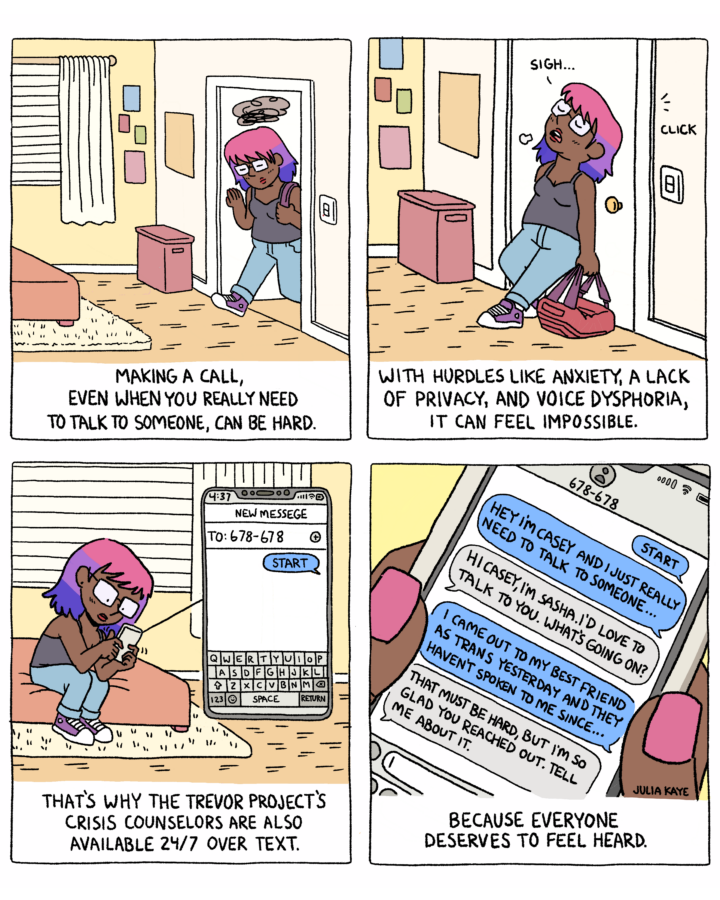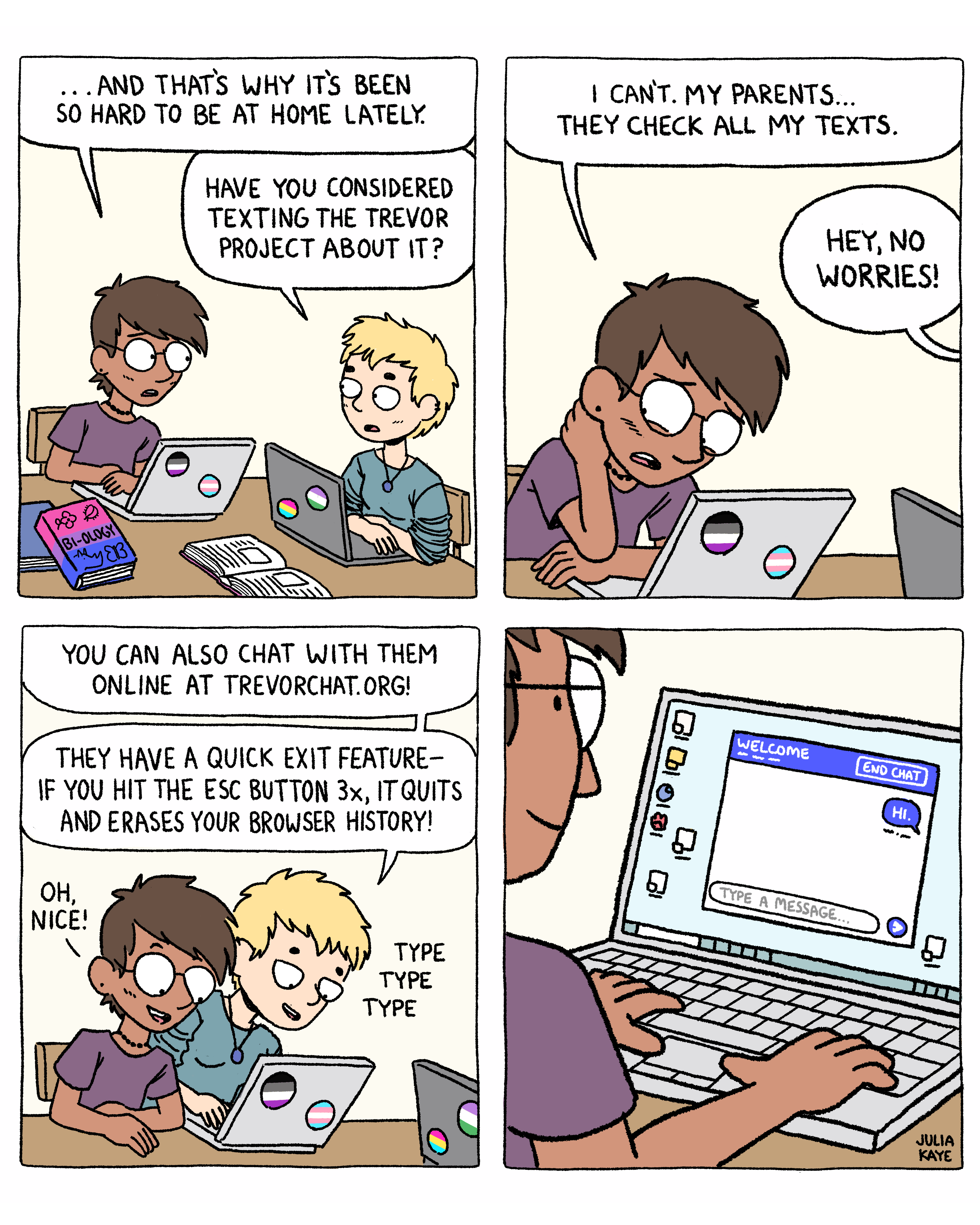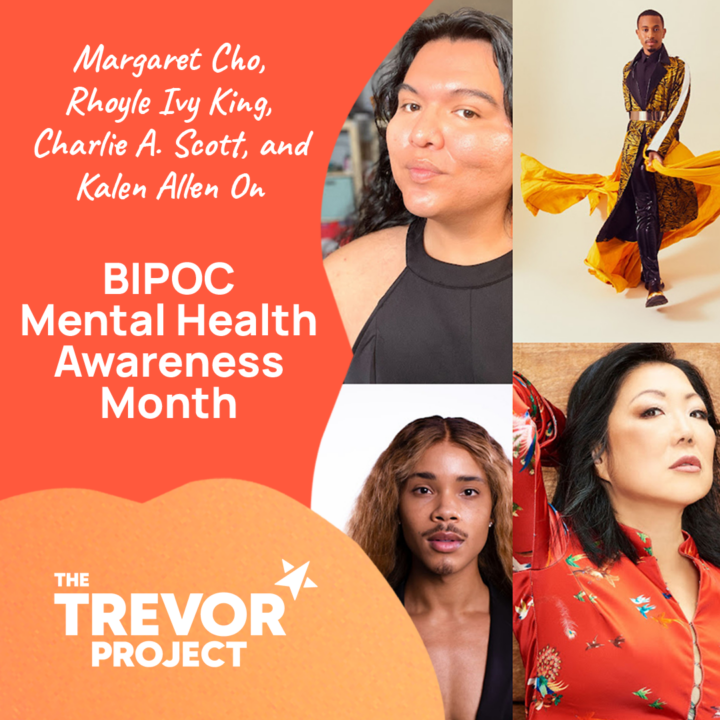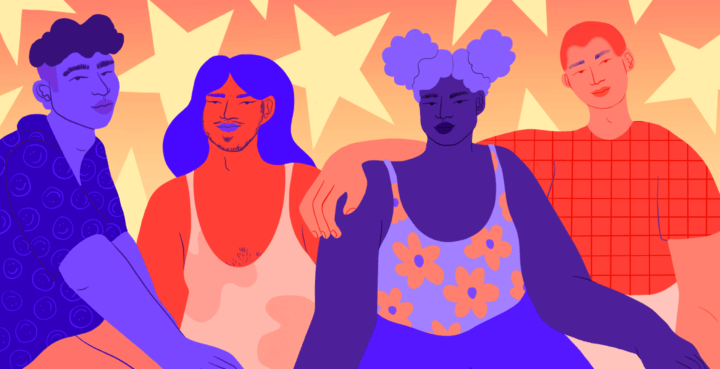Julia Kaye (she/her) is an award-winning illustrator, cartoonist, and author based in Los Angeles.
Currently a storyboard artist & revisionist at Disney, Julia has received critical acclaim for her deeply personal works Super Late Bloomer: My Early Days In Transition and My Life In Transition: A Super Late Bloomer Collection, which document the various stages of her gender transition.
Julia’s signature autobiographical style lets audiences into her innermost thoughts — from moments of insecurity and dysphoria, to feelings of confidence and optimism, no emotion is left unexplored. Through candor, vulnerability, and humor, Julia’s art normalizes the everyday trans experience to help create a safer, more inclusive world for LGBTQ young people.
As longtime fans of her work, we reached out to Julia to create a series of comic strips that illustrate The Trevor Project’s free and confidential crisis services — TrevorLifeline, TrevorChat, TrevorText — as well as TrevorSpace, the world’s largest safe space social networking site for LGBTQ young people. Her impactful imagery depicts the nuanced set of challenges that LGBTQ youth face on a daily basis and shows them that they are loved, supported, and never alone.
We sat down with Julia to discuss how she got involved in the comic industry, the importance of trans representation in the media, and tips for how LGBTQ young people can use art as a tool for self-expression and discovery.
Your comics are intimate snapshots of your personal experiences and anxieties. How does it feel letting people into your internal monologue?
It’s honestly a little strange if I think too much about it! The comics I’ve shared with the world are quite literally my personal diary. It can be scary to be so publicly vulnerable, but seeing so many people respond that my work has made them feel seen has been incredibly rewarding! I used to be an extremely closed off person and opening up in such a public way has helped me to grow in confidence.
What drew you to the medium of comics? Did you read comics growing up?
Oh definitely, comics have always been a big part of my life. As a kid I used to tear through the daily newspaper comics section every morning. I’d read them all from top to bottom, even the ones I didn’t enjoy very much (looking at you, Rex Morgan M.D.!). I was a huge fan of strips like Garfield, Calvin and Hobbes, and Foxtrot in particular. My dad loved superheroes, so I also grew up reading whatever he had lying around the house. And when manga started appearing on the shelves of bookstores in the early 2000s, I dove into them too!
Discovering webcomics as a teen was the big game changer for me. Finding strips online being made by people not much older than me made it all seem so much more accessible. I felt like I was being spoken to in a way that truly resonated for the first time. Comics like Gunshow, Dar, Hark! A Vagrant, and Johnny Wander felt groundbreaking! The worlds of publishing and newspaper syndication had always felt shrouded in mystery to me, but the internet? That I understood. I knew it would eventually be the path forward for me.
What was your creative process behind the series you developed for The Trevor Project’s crisis services? How was it different creating a comic strip outside of your signature autobiographical style?
The process was pretty similar! I usually start my process by deciding the goal for what I want to express, create a script, roughly work out the visuals for each panel, and then bring it all together to create the final art. When working with the team from The Trevor Project, I guided them through my process, helping them hone in on exactly what they were looking to say. It was a fun back and forth process getting to the end result and I’m proud of what we were able to create together!

Why was it important for you to use your own gender transition as the backdrop for your books Super Late Bloomer and My Life In Transition?
I wanted to make the sort of books that I wished could have existed when I was younger, or even when I was coming out. Having access to simple, easy-to-read books that validated my identity and felt relatable to the experiences I was having would have helped so much! I also wished that I had access to a resource like that to help my friends and family better understand me, to help open up conversations and discussions.
It felt vital to make these books so that others could have an easier time with their own journeys. It’s been just incredible to hear how they’ve affected so many people’s lives and how the books have paved the way for better understanding.
How can LGBTQ young people use art to express or discover themselves?
There are so many ways you can use art as a tool for self-expression, exploration, or as therapy. It really depends on what you enjoy doing! There’s writing, drawing, painting, playing music, dancing, crafting, and so much more.
What’s worked for me in particular has been to set aside a small, manageable period of time each day (even if just 5 or 10 minutes!) to step back from the world and think about what was the most emotionally impactful event for me that day. Was it positive? Negative? A confusing mix of both? Then I’ll create something that focuses on and explores that feeling, without any judgment about the end result. I try to forget about trying to make something pretty or perfect, allowing myself to be messy and make “mistakes”.
Challenge yourself to do it every day for a week, or a month, or really whatever feels manageable. Try to make it a habit! Going through the process regularly over time can go a long way toward helping you better understand yourself.
You’ve stated that your comics were not initially meant to be public. What empowered you to release your work to the world?
Yeah, they had originally started out as art therapy for myself. My sketchbook became a private place where I could express sentiments I didn’t know how to talk about with other people, or in some cases, felt too ashamed to otherwise admit!
The two main factors that empowered me were time and the encouragement of my friends. Letting the comics sit in my sketchbook for 7 or 8 months before sharing them publicly helped me emotionally distance myself from the raw emotions I had felt while making them. Enough time had passed that I had grown a lot as a person and was better equipped to talk about my experiences.
The exception to my not sharing them publicly was when I occasionally showed them to close friends, to help them better understand what I was then currently going through. They were super encouraging and helped me to see the value in what I was creating. They let me know that if I ever felt comfortable sharing them publicly one day, my comics could help a lot of people feel less alone in their experiences. I’m so glad they did.

How do you get through creative blocks if you’re feeling uninspired?
I do something else for a while! Over time I’ve learned to accept that I go through periods of input and periods of output. Sometimes my noggin just wants to take in media and experiences and other times I just want to create. There’s no need to always be a constantly creating machine, it’s ok to do other things! Art will always be there when I feel ready to go back to it.
Since your transition five years ago, how has the content of your work evolved?
I feel like I’ve come to a much better understanding of my personal voice and, because of that, my art has become way more representational of me. Before I began to accept myself as a woman, I never felt like I had a great grasp on my identity, and that spilled over into my art as well. Looking back on my old art can be a little strange now, all I see is someone who was trying to be anyone but herself! I now have a much better sense of the type of things I want to create and the energy I want to put out into the world.
What advice would you give LGBTQ young people who are struggling with their sexual orientation or gender identity?
It can feel challenging to try to understand yourself, but it’s well worth it to put in the work to figure it out. Try to keep in mind that it’s totally ok to try new things for yourself — be it changing up your pronouns, name, identity labels, whatever! And it’s also ok for your feelings about any of it to change over time, or for the thing you’re trying out to not feel right for you after all! As people, we’re all constantly growing and shifting and evolving. Allow yourself to evolve. We’re all just trying our best.
Learn more about Julia Kaye and her work at juliakaye.com and @upandoutcomic on Instagram.


